Back to Journals » Advances in Medical Education and Practice » Volume 16
Assessment of Confidence Levels of Undergraduate Senior Dental Students and Interns’ During Endodontic Treatment Procedures in a Sample From Saudi Arabia
Authors Madfa AA , Almansour MI, Al‑Zubaidi SM, Almohefer SA, Alajlan SS, Alsaleh MK, Alanazi YA, Alajlan AS
Received 27 August 2024
Accepted for publication 14 December 2024
Published 4 February 2025 Volume 2025:16 Pages 165—176
DOI https://doi.org/10.2147/AMEP.S488032
Checked for plagiarism Yes
Review by Single anonymous peer review
Peer reviewer comments 2
Editor who approved publication: Dr Md Anwarul Azim Majumder
Ahmed A Madfa,1 Moazzy I Almansour,1 Saad M Al‑Zubaidi,1 Sami A Almohefer,1 Sarah S Alajlan,1 Mohammed K Alsaleh,1 Yosef A Alanazi,2 Abdalellah S Alajlan2
1Department of Restorative Dental Science, College of Dentistry, University of Ha’il, Ha’il, Kingdom of Saudi Arabia; 2Dental Student, College of Dentistry, University of Ha’il, Ha’il, Kingdom of Saudi Arabia
Correspondence: Ahmed A Madfa, Department of Restorative Dental Science, College of Dentistry, University of Hail, Hail, Kingdom of Saudi Arabia, Tel +966165358200, Email [email protected]
Background: The evaluation of students’ impression regarding their dental college experience is a crucial indicator of the effectiveness and achievement of dental education. The aim of this study is to evaluate the levels of confidence demonstrated by senior dental students and new interns during the execution of various endodontic treatment at College of Dentistry, University of Hail.
Methods: A total of 76 senior students and 21 new interns at the University of Hail, Saudi Arabia, were administered anonymous surveys. Participants were instructed to assess their level of self-confidence using a Likert scale that spanned from 1 to 5. The statistical significance between the analysed groups was assessed using the Mann–Whitney U-test and the chi-squared test.
Results: 63.9% of participants indicated their satisfaction with the quantity of teeth that were determined to require treatment. The majority of participants (91.8%) indicated that they believe their confidence in the field of endodontics will be strengthened by greater exposure to practical experience. Around 49.5% of the respondents indicated their intention to seek specialization in the future. Overall, the results of this study indicate that students and males tend to have lower levels of self-confidence in various endodontic procedures compared to interns and females (p < 0.05). A significant difference (p < 0.05) was noted in the levels of confidence between students and interns in treating various teeth. However, there were no statistically significant differences between the genders (p > 0.05). There were no statistically significant differences (p > 0.05) observed in the self-confidence levels related to the management of various indications between the two groups.
Conclusion: The level of confidence pertaining to endodontic treatment among the participants is deemed satisfactory. The dental interns demonstrated a notable degree of self-assurance in executing root canal therapy, primarily attributable to their extensive engagement in clinical practice.
Keywords: confidence, endodontics, education, dental students, self-assessment
Introduction
Many dental students hold the belief that dentistry is a highly demanding profession, necessitating a combination of altruism and substantial financial investment. Furthermore, this educational approach encompasses various components, such as periodic assessments, fostering a constructive rapport between patients and students, and effectively implementing theoretical concepts in real-world scenarios. The perspectives of individuals about their educational experiences play a pivotal role in the process of curriculum building. These viewpoints serve as valuable insights that can inform and guide enhancements to educational programs, ultimately leading to improvements in the overall learning process.1–3
Endodontic therapy is considered one of the most complex dental procedures in the field of dentistry, posing significant challenges for both general dentists and undergraduate dental students. This challenge is believed to arise from recent advancements in the clinical management of pulp and periapical diseases, the intricate anatomical variations, and the extensive range of instruments, materials, and treatment techniques that have been developed. Additionally, there is a lack of confidence among certain students, which leads them to feel inadequately prepared to perform endodontic treatment procedures.4
Upon completion of their academic pursuits, recent graduates articulate their degree of self-assurance in independently performing a diverse range of dental procedures. In the future, when individuals commence their careers as autonomous dental practitioners, this metric may function as an indicator of their ability to provide comprehensive and high-caliber dental healthcare services.5,6 The acquisition of information and the development of self-assurance is ultimately beneficial for dentists in effectively managing stress during dental treatments. In contrast, it has been observed that dentists who possess lower levels of education and experience tend to demonstrate elevated levels of stress during the provision of patient care.7 The observed phenomenon is postulated to arise from a multitude of reasons, encompassing the intricate nature of the technical protocols, limited understanding of the underlying concepts and objectives of the treatment, insufficient education at the undergraduate level, and inadequate remuneration for the extensive workload involved.7 In order to cultivate the necessary levels of expertise, it is imperative that students are provided with ample exposure to a diverse range of endodontic situations, encompassing varied levels of difficulty. Endodontics is a dental specialty that encompasses a range of graduation requirements imposed by dental schools and dental programmers. The number of endodontic treatments required for graduation may vary due to factors such as the patient-to-student ratio at the dentistry school. This is supported by previous research.8
The course titled “Endodontics” is designed for undergraduate students with the objective of equipping them with the necessary knowledge and skills to proficiently perform endodontic therapy as dentists. Based on many studies, it has been observed that general practitioners exhibit a high level of self-assurance in their proficiency to perform root canal procedures.9,10 While the occurrence of periradicular disease may often be overlooked and left untreated, some studies have indicated a notable prevalence of inadequately executed root canal treatments.11–15
It is imperative to assess the degrees of self-confidence exhibited by senior dentistry students when doing endodontic treatments.8 However, there is a limited amount of available data regarding the perceptions of students towards endodontics and their levels of confidence in different aspects of endodontic therapy with regards to their prospective professional paths. To date, there has been a lack of investigation into the trust levels pertaining to different aspects of root canal therapy within University of Hail. The objective of the present study is to assess the degrees of confidence exhibited by senior dental students and new interns enrolled in the University of Hail’s college of dentistry while performing different endodontic treatment procedures.
Materials and Methods
Study Design
This cross-sectional study was conducted in college of dentistry at University of Hail, Hail, Saudi Arabia.
Bioethical Considerations
The present study received approval from the scientific committee of the dental college at the University of Hail, ensuring adherence to ethical guidelines and the protection of participant confidentiality. The poll was conducted on a voluntary basis, with participants being required to provide a signed agreement. The data were maintained in a confidential manner and were exclusively utilized for the objectives of this study.
Study Population
This study was conducted during the last week of the academic year in June 2023 through a self-administered questionnaire among 76 final years dental students. Twenty-one dental interns in all who had successfully finished their rotational posting at the College of Dentistry were chosen to take part in the survey. Experts in the field reviewed the questionnaire’s construct validity and content. Additionally, five interns were given the questionnaire to complete in order to verify its internal validity. Located in Hail, Saudi Arabia, this college is known for its efficient management and excellent facilities. The provision of complimentary dental treatment has resulted in a significant influx of individuals seeking dental services at dental polyclinics. This dental treatment is being carried out by undergraduate students under the supervision of instructional staff members. The recruited population consisted of patients residing in Hail City and its surrounding areas. Boasting a population above one million inhabitants, this city stands as the largest in the Northern Region of Saudi Arabia.
Prior to the commencement of the study, participants were informed that it was not obligatory for them to complete and submit the forms. Additionally, they were assured that their academic performance or grade would not be influenced by their participation in the survey. The participants were instructed to assess the different phases of endodontic treatment such as history taking, diagnosis and treatment planning, radiograph taking, injecting local anesthesia, endodontic cavity preparation, rubber dam placement, measuring working length by radiograph, root canal shaping by hand files, root canal irrigation, root canal obturation, management of inter-appointment flare-ups, final restoration. Additionally, the participants were directed to assess how various endodontic indications were managed such as vital pulp treatments, irreversible pulpitis, necrotic pulp, symptomatic apical periodontitis and acute abscess, asymptomatic apical periodontitis, and chronic abscess, endo-perio lesions, traumatic cases, root resorptions, immature apices, non-surgical endodontic retreatment, emergency cases in general. The participants were also asked about their respective levels of confidence in doing root canal treatment for various types of teeth. The participants in the study expressed their level of confidence using the Lickert’s scoring technique, which is a scale ranging from one to five. The numerical scale ranging from 1 to 5 is used to represent varying levels of confidence. Specifically, a score of 1 indicates minimal confidence, 2 signifies a moderate level of confidence, 3 represents a neutral stance, 4 defines a considerable degree of confidence, and 5 signifies a high level of confidence.
The study participants were also queried regarding their perception of the adequacy of the mandated quantity of endodontic cases. The participants were moreover inquired about their prospective strategies for establishing their own endodontic practice, encompassing their intentions to independently conduct all endodontic procedures or alternatively, to refer patients to professionals when necessary. The participants were also queried regarding their perceptions of the difficulty level associated with the subject of endodontics and their inclination towards selecting it as a specialization.
Statistical Analysis
Descriptive statistical approaches were employed to conduct data analysis using SPSS 21.0 for Windows (SPSS Inc., Chicago, IL, USA). The statistical significance of the differences between dental students in their final year and new interns was evaluated by the use of the Mann–Whitney U-test and the chi-squared test. The significance level of 5%.
Results
Out of the total sample size of 97 participants, it was observed that 76 respondents (78.4%) were senior undergraduate students, whilst the remaining 21 participants (21.6%) were interns. The study found that 42.3% of the subjects identified as male, whereas 57.7% identified as female.
In general, the self-confidence levels pertaining to different endodontic operations exhibited lower scores among senior students and males in comparison to interns and females, as indicated by the data presented in Table 1 and Table 2. Statistically significant differences were observed between both groups (p < 0.05). The findings of the study indicated that participants had the least amount of trust in managing intra inter-appointment flare-ups. In the context of undergraduate students, it was observed that better levels of self-confidence were associated with the practice of root canal irrigation. Nevertheless, it was seen that interns achieved greater marks in the domain of history taking.
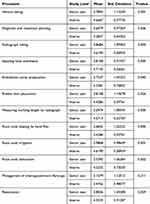 |
Table 1 Average Self-Confidence Scorings of Senior Year Students and Interns for Various Endodontic Procedures of Different Teeth |
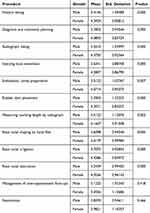 |
Table 2 Average Self-Confidence Scorings of Males and Females’ Students for Various Endodontic Procedures of Different Teeth |
During the assessment of self-confidence levels pertaining to various teeth during the execution of root canal treatment, it was observed that undergraduate students exhibited comparatively lower levels of confidence in comparison to freshly appointed interns. Statistically significant differences were observed between both groups (p < 0.05), as evidenced by the findings presented in Table 3. Male participants had marginally higher levels of confidence in comparison to their female counterparts. Nevertheless, the analysis revealed no statistically significant disparities between the two groups, as shown by a p-value greater than 0.05, as presented in Table 4. The results indicated that both undergraduate students and interns expressed the lowest level of confidence in treating maxillary molars, followed by mandibular molars (Table 3).
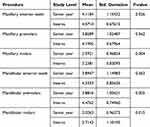 |
Table 3 Average Self-Confidence Scorings of Senior Year Students and Interns About Various Endodontic Procedures of Different Teeth |
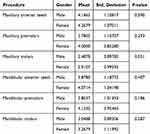 |
Table 4 Average Self-Confidence Scorings of Males and Females’ Students About Various Endodontic Procedures of Different Teeth |
Table 5 presents the scores pertaining to the levels of self-confidence exhibited by the management personnel across various endodontic indications. The self-confidence levels of undergraduate students were found to be somewhat lower in comparison to those of newly interned individuals. Nevertheless, the study did not yield any statistically significant differences between the two groups (p > 0.05). Male participants had marginally higher levels of confidence in comparison to their female counterparts. Nevertheless, the analysis revealed no statistically significant disparities between the two groups, as shown by a p-value greater than 0.05, as presented in Table 6. Cases with immature apices, root resorptions, and trauma were identified as the clinical scenarios in which both undergraduate dental students and interns expressed the least amount of confidence.
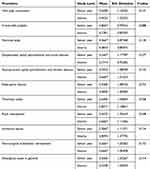 |
Table 5 Average Self-Confidence Scorings of Senior Year Students and Interns for Management of Different Endodontic Indications |
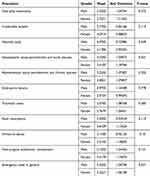 |
Table 6 Average Self-Confidence Scorings of Males and Females’ Students for Management of Different Endodontic Indications |
A significant proportion of the participants, namely 86.6%, expressed their intention to seek consultation from a specialist when faced with complex endodontic cases that exceeded their level of expertise. A majority of the participants, specifically 63.9%, expressed satisfaction with the number of teeth that were deemed necessary for treatment. The findings indicate that a significant proportion of the participants (91.8%) expressed their belief that their confidence in the field of endodontics will be enhanced via increased exposure to practice and treatment of diverse endodontic situations. Approximately 49.5% of the participants expressed a desire to pursue specialization in the field of endodontics in the future.
Discussion
In order to enhance their advanced clinical competence and general clinical experience, senior dental students are mandated to engage in endodontic procedures. The objective of the curriculum development process is to enhance the quality of endodontic care provided by senior dental students, which is achieved through several means. The measures encompassed the augmentation of educational tools and resources, the provision of additional training and support, and the implementation of regulations aimed at upholding rigorous performance expectations for students. This study highlights the overarching importance of continuous assessment and feedback in dentistry education pertaining to the field of endodontics. The utilization of student surveys and curriculum revisions within the dentistry college has the potential to enhance the educational experience for students, hence improving the quality of patient treatment.16
The curriculum for endodontology in our dental college spans three academic years, specifically the fourth, fifth, and sixth years of study. The endodontic preclinical programme serves as a fundamental component and initiation into the field of specialization. It is widely recognized as a crucial stage in developing the essential skills and knowledge required for delivering proper endodontic treatment to patients. The course known as Preclinical Endodontics (RDS 414) is intended for fourth-year students and has a primary focus on equipping them with the necessary skills to recognize, diagnose, and effectively treat dental conditions related to the pulp and surrounding tissues of the teeth. The lectures in endodontics provide a significant emphasis on the interrelation between fundamental clinical and biological principles, thereby underscoring the core tenets of this field. Preclinical training on the execution of root canal treatment (RCT) was provided to dental students during the initial two semesters. This instruction focused on performing RCT procedures on extracted teeth with single or multiple roots, which were mounted on acrylic surfaces. Enrollment in the clinical endodontics (NAN 542) course is limited to students in their fifth year of study who have satisfactorily fulfilled the requirements of both the theoretical and practical components of RDS 415. This course expands upon the theoretical foundation established in NAN 442, providing students with practical clinical exposure and the opportunity to engage in real-world patient care. The primary emphasis of the course is in the convergence of clinical and biological principles. The students will receive instruction on both anterior and posterior teeth that have endodontic involvement. Additionally, participants will receive instruction in the management of serious injuries and endodontic crises. The sixth year’s Comprehensive Care Clinics (CCC 600) course is responsible for managing the most intricate situations across several disciplines.
The objective of this study was to assess the degrees of confidence exhibited by senior students and interns during the execution of endodontic procedures. It is imperative that dental interns possess the necessary competence to autonomously execute endodontic operations.8,17,18 The lack of self-confidence among dental students in autonomously executing endodontic procedures, due to their inherent complexity, has the potential to impact the overall result of such treatments. There was a discernible disparity in the overall self-confidence levels exhibited by the two groups during the several stages of endodontic treatment. Specifically, the dental intern group consistently demonstrated a notably elevated degree of confidence. The observed outcome can be ascribed to variations in skill levels. Consequently, interns exhibited a heightened sense of self-assurance and proficiency in executing endodontic procedures. The results obtained were consistent with the findings reported by Puryer et al.19
In the current investigation, a significant proportion of dental interns exhibited a higher level of confidence in executing various endodontic treatments with patients throughout treatment, as compared to their student counterparts. The potential reason for this diminished level of confidence could be attributed to the fact that these methods exhibit a higher degree of sensitivity to technique.20,21 The study found that the “Management of inter appointment flare ups” had the lowest mean confidence score. A flare-up is defined as a sudden exacerbation of periapical disease following the initiation of nonsurgical endodontic treatment.22 Flare-ups may arise due to a range of factors, encompassing apical extrusion of pulpal and dentinal debris, excessive instrumentation, insufficient removal of pulp tissue, irritation caused by chemical substances (such as medicaments and irrigants), excessive obturation, microbiological factors, root fractures, and hyperocclusion.23 The conclusion aligns with other studies, which also revealed reduced confidence among students.8,24
The participants in this study had a lower degree of confidence when treating molars in comparison to other teeth. Molars exhibit anatomical variations of varying intricacy. Therefore, the endodontic treatment of these cases poses challenges and has a negative impact on the students’ self-confidence during the treatment process.25–28 The challenging nature of treating and re-treating molars can be attributed to factors such as their specific anatomical features, geographical placement within the oral cavity, as well as the absence of certain skills and experience required for their management. The participants in the current investigation indicated a decreased level of self-assurance when carrying out the root canal procedure on maxillary and mandibular molar teeth. The results were in line with the conclusions drawn in previous studies.18,24,29 The observed phenomenon can be ascribed to the acquisition of clinical experience and skills by students as they advance through their academic levels.19 Furthermore, a gender-based examination of confidence levels in relation to tooth types indicated that male students exhibited considerably higher levels of confidence in treating mandibular anterior teeth compared to their female counterparts. Previous studies have also observed a comparable gender disparity, wherein male students demonstrated higher levels of self-confidence when performing difficult endodontic treatments.16,17 Gender disparities were also evident in the medical school setting, as female students consistently reported lower levels of confidence in their competence compared to their male counterparts.30
The outcomes of the study indicate that students expressed reduced levels of confidence when faced with complex endodontic cases, such as those involving teeth with open apices, root resorption, and endo perio lesions. The handling of the aforementioned circumstances is beyond the scope of the expected competencies for undergraduate dental students. Tanalp et al reported comparable findings in their research.8 The authors additionally contended that it is imperative for pupils to be provided with opportunities to encounter intricate endodontic scenarios. The opportunity for exposure will facilitate their ability to identify and then recommend patients to the endodontist that exceed their level of knowledge. The Association for Dental Education in Europe has asserted that dental students must possess the necessary skills to accurately recognise the indications for complex nonsurgical and surgical endodontic procedures and respond accordingly.31 Hence, the academic standpoint suggests that the comparatively reduced confidence level associated with complex endodontic operations should not be a cause for alarm. However, it is important to acknowledge that this represents the current constraints on the skills and abilities that undergraduate dentistry students are expected to attain.
In the assessment of several endodontic scenarios, this study observed that participants, namely interns and males, exhibited greater levels of confidence when managing irreversible pulpitis, vital pulp treatments, acute apical periodontitis, and necrotic pulp with abscess. In addition to the absence of experience and skills, the apprehension of failure, incidents, and complexities also exerts an influence on one’s degree of confidence. Hence, it is vital for interns to acquire proficiency in the requisite abilities, methodologies, and self-assurance, thereby surmounting the aforementioned factors. Hence, it is imperative to implement problem-based methodologies, provide targeted instruction in the management of intricate clinical scenarios, and integrate a competency-based framework into dental education in order to enhance the proficiency and self-assurance of dental interns upon completion of their training.8,16
The level of practical instruction that students receive is anticipated to manifest in their self-assurance and proficiency in the specific field of study.15 Nevertheless, there is not always a direct correlation between students’ self-confidence levels, which refer to their opinion of their own skill, and their actual competency.32 Furthermore, it should be noted that the level of proficiency of students in clinical endodontic situations cannot always be accurately determined only based on the number of cases they perform.20 Nevertheless, it is probable that an augmented amount of exposure to structured clinical practice will enhance the level of confidence and proficiency among students.33 Hence, it is of utmost significance that undergraduate dentistry students are provided with sufficient practical opportunities to engage in endodontic operations.34 Consequently, Hail University mandates that students engage in a collaborative effort to conduct endodontic procedures on a minimum of 18–20 teeth throughout their preclinical and clinical training sessions. A significant proportion of students conveyed their contentment with the minimal quantity of root canal procedures they were mandated to undertake. The current study demonstrated the efficacy of competency-based education in enhancing students’ metacognitive abilities. Specifically, nearly 80% of the participants expressed their intention to consult a specialist when faced with hard circumstances that exceed their own expertise in their future professional practice. The results obtained were similar to those reported in the earlier study.8 Furthermore, a significant proportion of the student population expressed a keen inclination in pursuing a career in the field of endodontics. The findings were consistent with the results of prior studies.35,36 In contrast, alternative research investigations have reported a decreased proportion of students who expressed interest in pursuing a specialization in endodontics.8,29 The inquiry pertaining to the students’ inclination towards different file systems yielded insights into their perspectives on the application of modern endodontic devices in clinical settings.
The current investigation exhibited certain limitations. First of all, it is crucial to recognize that this study has limited scope because it only looks at a single institution, which could limit how broadly the results can be applied to other dental students from various universities in the kingdom. To improve the supply of thorough knowledge and skills in the field of endodontics, multicenter studies are therefore essential for identifying areas of weakness and creating workable solutions. Given that the study assessed an extent of confidence, it is reasonable to assume that students will sometimes overestimate their level of competence. However, practice necessitates both a reasonable amount of confidence and expertise. Furthermore, the assessment of confidence levels among students is highly subjective, with individual variances being influenced by their diverse and irrelevant experiences. Notwithstanding these constraints, the present study can provide a foundation for other investigations.
Conclusions
Based on the limitations of the research, the authors drew the conclusion that the dental interns exhibited a high level of confidence in performing root canal treatment, particularly as a result of their exposure to clinical experiences. There is a requirement for an augmentation in clinical hours, exposure to a wider range of cases, and a revision in the approach to developing skill-based proficiency among graduating interns in order to enhance their levels of confidence and competence in the field. There should be an emphasis on pre-clinical courses and more clinical exposure to more intricate operations in order to enhance the refinement of their skills. It is imperative to identify the areas of weakness in endodontic treatment in order to effectively address and improve the proficiency of abilities required for performing endodontic treatments. This study exclusively evaluated the degrees of confidence, without considering the levels of competence. Given that the questionnaire was self-administered and focused on individuals’ self-perceived confidence levels, it is important to acknowledge the potential presence of information bias.
Data Sharing Statement
The datasets are available and accessible from the corresponding author upon reasonable request.
Informed Consent
The participants provided their informed consent to partake in the study.
Disclosure
The authors state that they have no conflicting interests.
References
1. Divaris K, Barlow PJ, Chendea SA, et al. The academic environment: the students’ perspective. Eur J Dent Educ. 2008;12(s1):120–130. doi:10.1111/j.1600-0579.2007.00494.x
2. Lagali-Jirge V, Umarani M. Evaluation of readiness to practice among interns at an Indian dental school. J Contemp Med Edu. 2014;2(4):227–231. doi:10.5455/jcme.20141105071940
3. Sadozai SRK, Bhutta N, Chatha MR. Self-reported confidence levels of dental graduates in performing clinical procedures. Pak Oral Dent J. 2015;35:681–686.
4. Lanning SK, Wetzel AP, Baines MB, Ellen Byrne B. Evaluation of a revised curriculum: a four-year qualitative study of student perceptions. J Dent Educ. 2012;76(10):1323–1333. doi:10.1002/j.0022-0337.2012.76.10.tb05387.x
5. Martins RC, Seijo MO, Ferreira EF, Paiva SM, Ribeiro-Sobrinho AP. Dental students’ perceptions about the endodontic treatments performed using NiTi rotary instruments and hand stainless steel files. Braz Dent J. 2012;23(6):729–736. doi:10.1590/S0103-64402012000600018
6. Paudel S, Subedi N, Shrestha A. Stress and its relief among undergraduate dental students in a tertiary health care centre in Eastern Nepal. Dentistry. 2013;3(01):157. doi:10.4172/2161-1122.1000157
7. Jahromi MJ, Golparvar M, Kheir MK. Strategies of coping with stress during root canal therapy. Avicenna J Dent Res. 2016;8:e24347.
8. Tanalp J, Güven EP, Oktay I. Evaluation of dental students’ perception and self-confidence levels regarding endodontic treatment. Eur J Dent. 2013;7(02):218–224. doi:10.4103/1305-7456.110189
9. Abdullah M, Ab Aziz ZA, Saub R, Murat N. General dental practitioners’ confidence in performing molar root canal treatment. Malays J Comput Sci. 2009;16:9–14.
10. Saunders WP, Chestnutt IG, Saunders EM. Factors influencing the diagnosis and management of teeth with pulpal and periradicular disease by general dental practitioners. Part 1. Br Dent J. 1999;187(9):
11. Soares SM, Soares JA, Homem MA, et al. A cross-sectional study of the factors affecting the periapical status of endodontically treated teeth. Res Rev J Med Health Sci. 2016;5:1–7.
12. Craveiro MA, Fontana CE, de Martin AS, Bueno CE. Influence of coronal restoration and root canal filling quality on periapical status: clinical and radiographic evaluation. J Endod. 2015;41(6):836–840. doi:10.1016/j.joen.2015.02.017
13. Sarıyılmaz E, Keskin C, Özcan Ö. Retrospective analysis of post-treatment apical periodontitis and quality of endodontic treatment and coronal restorations in an elderly Turkish population. J Clin Gerontol Geriatr. 2016;7(1):17–20.
14. Mirza MB. Difficulties encountered during transition from preclinical to clinical endodontics among Salman bin Abdul Aziz University dental students. J Int Oral Health. 2015;7(Suppl 1):22–27.
15. Davey J, Bryant ST, Dummer PM. The confidence of undergraduate dental students when performing root canal treatment and their perception of the quality of endodontic education. Eur J Dent Educ. 2015;19(4):229–234. doi:10.1111/eje.12130
16. Madfa AA, Senan EM. Perception and confidence levels among dental students and interns in performing various endodontic procedures. J Oral Res. 2019;8(3):185–195. doi:10.17126/joralres.2019.029
17. Qamar R, Noor N, Khan Q, Jalees M, Manzoor MA, Abbasi S. Evaluation of house officers confidence level in performing endodontic treatment. Pakistan Oral Denl J. 2018;38(2):268–273.
18. Alrahabi M. The confidence of undergraduate dental students in Saudi Arabia in performing endodontic treatment. Eur J Dent. 2017;11(1):17–21. doi:10.4103/ejd.ejd_190_16
19. Puryer J, Amin S, Turner M. Undergraduate confidence when undertaking root canal treatment and their perception of the quality of their endodontic education. Dent J. 2016;5(1):1–10. doi:10.3390/dj5010001
20. Gilmour AS, Welply A, Cowpe JG, Bullock AD, Jones RJ. The undergraduate preparation of dentists: confidence levels of final year dental students at the school of dentistry in Cardiff. Br Dent J. 2016;221(6):349–354. doi:10.1038/sj.bdj.2016.686
21. Seijo MO, Ferreira EF, Ribeiro Sobrinho AP, Paiva SM, Martins RC. Learning experience in endodontics: Brazilian students› perceptions. J Dent Educ. 2013;77(5):648–655. doi:10.1002/j.0022-0337.2013.77.5.tb05515.x
22. American association of endodontics: glossary of endodontic terms, 10th ed. Chicago: American Association of Endodontists; 2019. Available from: https://www.aae.org/specialty/download/glossary-of-endodontic-terms/.
23. Dorn SO, Cheung GS. Management of endodontic emergencies. In: Berman L, Hargreaves K, editors. Pathways of the Pulp.
24. Ayhan T, Barut G, Tanalp J. The self-confidence levels of senior dental students during endodontic treatment procedures. Turk Endod J. 2016;1(1):19–22. doi:10.14744/TEJ.2016.25743
25. Honey J, Lynch CD, Burke FM, Gilmour AS. Ready for practice? A study of confidence levels of final year dental students at Cardiff University and University College Cork. Eur J Dent Educ. 2011;15(2):98–103. doi:10.1111/j.1600-0579.2010.00646.x
26. Holmes DC, Diaz-Arnold AM, Williams VD. Alumni self-perception of competence at time of dental school graduation. J Dent Educ. 1997;61(6):465–472. doi:10.1002/j.0022-0337.1997.61.6.tb03138.x
27. Bartlett DW, Coward PY, Wilson R, Goodsman D, Darby J. Experiences and perceptions of vocational training reported by the 1999 cohort of vocational dental practitioners and their trainers in England and Wales. Br Dent J. 2001;191(5):265–270. doi:10.1038/sj.bdj.4801159a
28. Javed MQ, Khan AM, Bhatti UA. Evaluation of undergraduate dental students self-perceived confidence level regarding endodontic procedures: a questionnaire survey. Saudi Endodontic J. 2021;11(2):228–234. doi:10.4103/sej.sej_155_20
29. Almohaimede AA. Clinical undergraduate endodontic teaching in King Saud University: student’s experience, perception, and self-confidence levels. Int J Dent Oral Health. 2018;4:1–5.
30. Blanch DC, Hall JA, Roter DL, Frankel RM. Medical student gender and issues of confidence. Patient Educ Couns. 2008;72(3):374–381. doi:10.1016/j.pec.2008.05.021
31. Cowpe J, Plasschaert A, Harzer W, Vinkka-Puhakka H, Walmsley AD. Profile and competences for the graduating European dentist-update 2009. Eur J Dent Educ. 2010;14(4):193–202. doi:10.1111/j.1600-0579.2009.00609.x
32. Woolliscroft JO, TenHaken J, Smith J, Calhoun JG. Medical students’ clinical self-assessments: comparisons with external measures of performance and the students’ self-assessments of overall performance and effort. Acad Med. 1993;68(4):285–294. doi:10.1097/00001888-199304000-00016
33. Choudhry NK, Fletcher RH, Soumerai SB. Systematic review: the relationship between clinical experience and quality of health care. Ann Intern Med. 2005;142(4):260–273. doi:10.7326/0003-4819-142-4-200502150-00008
34. Youngson CC, Molyneux LE, Fox K, Boyle EL, Preston AJ. Undergraduate requirements in restorative dentistry in the UK and Ireland. Br Dent J. 2007;203(S5):9–14. doi:10.1038/bdj.2007.777
35. Murray CM, Chandler NP. Undergraduate endodontic teaching in New Zealand: students’ experience, perceptions and self‐confidence levels. Aust Endod J. 2014;40(3):116–122. doi:10.1111/aej.12084
36. Halawany HS, Binassfour AS, AlHassan WK, et al. Dental specialty, career preferences and their influencing factors among final year dental students in Saudi Arabia. Saudi Dent J. 2017;29(1):15–23. doi:10.1016/j.sdentj.2016.12.001
 © 2025 The Author(s). This work is published and licensed by Dove Medical Press Limited. The
full terms of this license are available at https://www.dovepress.com/terms.php
and incorporate the Creative Commons Attribution
- Non Commercial (unported, 3.0) License.
By accessing the work you hereby accept the Terms. Non-commercial uses of the work are permitted
without any further permission from Dove Medical Press Limited, provided the work is properly
attributed. For permission for commercial use of this work, please see paragraphs 4.2 and 5 of our Terms.
© 2025 The Author(s). This work is published and licensed by Dove Medical Press Limited. The
full terms of this license are available at https://www.dovepress.com/terms.php
and incorporate the Creative Commons Attribution
- Non Commercial (unported, 3.0) License.
By accessing the work you hereby accept the Terms. Non-commercial uses of the work are permitted
without any further permission from Dove Medical Press Limited, provided the work is properly
attributed. For permission for commercial use of this work, please see paragraphs 4.2 and 5 of our Terms.

